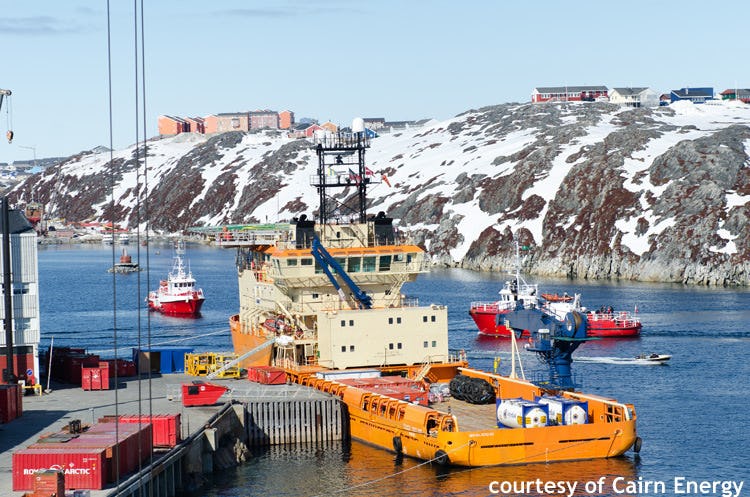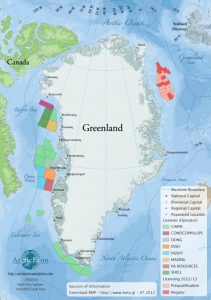Dimensions of Oil and Gas Development in Greenland

The prospect of offshore oil and gas activity in the waters around Greenland constitutes a highly contentious issue in the larger debate on Arctic petroleum development. Given Greenland’s special status as a part of the Danish Realm, with a high degree of self-governance and a majority Inuit population, oil and gas drilling there has engaged actors with a wide range of interests.
Arctic oil and gas development is often generalized into a two-sided conflict between those who emphasize the protection of the environment and those who seek potential profits, with the interests of local communities variably used in favor of one or the other depending on the area of the region under question. Some of the dimensions that seem to determine much of the actual development are often lost in this dichotomy, to the dismay of those in favor of an informed debate.
Taking into account that Greenland is just one of the many parts of the Arctic that is experiencing this development, with its own unique characteristics, this article sets out to shed light on the importance of internal political and commercial factors when discussing petroleum development around the island.
Historical Petroleum Development
Greenland was initially thought to have petroleum resources in the waters surrounding the island after seismic studies conducted in the early 1970s. The sudden price rise in oil in 1973 sparked interest in a part of the world that until then had been mostly known for its abundance of fish, shrimp and whale. Leases were offered to companies like Mobil, Amoco, Chevron and Total in 1975.
Drilling commenced in 1976 and 1977, with a total of five wells deemed dry. Later studies undertaken by the Geological Survey of Denmark and Greenland in 1997 discovered that these wells had been abandoned prematurely without complete knowledge about the existing resource potential. In 2000, however, a sixth well drilled by Statoil was also dry.1)
Renewed Interest
In the USGS’s appraisal from 2008, updated from the 2000 world report, the Greenlandic basin was estimated to contain approximately 17 billion barrels of oil and 138.000 billion cubic feet of natural gas.2) The Greenlandic self-government, in collaboration with Copenhagen, subsequently offered up parts of the sea west of Greenland for petroleum exploration in 2002 and 2004, resulting in only minor bids by small companies.
By 2006, however, the oil and gas industry had caught an interest for the region and the two licensing rounds* that year resulted in a total of seven licenses awarded to companies such as Statoil, Dong, Husky, Chevron, ExxonMobil and Cairn Energy. Other licensing rounds have followed and in the summers of 2010 and 2011 Scottish Cairn Energy conducted exploratory drillings at several sites off the coast of Greenland.
Economic Independence
Greenland is heavily dependent on economic transfers from Denmark to provide basic services. These amount to over DKK2.8 billion every year, with an additional DKK320 million coming from an annual grant from the European Union for fishing rights. The current self-government has been very positive towards oil and gas exploration, in addition to mineral extraction, hoping to provide a means for economic independence from Denmark.3) Governments in Copenhagen have, in addition, been strong supporters of continued development of these resources in Greenland, due to both revenue expectations and inclusion of Danish industry, like Dong Energy.
Although no big findings were reported from Cairn’s drillings, both the Greenlandic government and the other heavily invested oil companies like Shell, Husky, Dong, and Statoil are intent on commencing further exploratory drillings. This is mainly dependent on the results of seismic studies further north along the west coast, conducted in 2012 and 2013. Potential oil findings seem the most likely to be developed, given that any resource production would need to be exported to the international market for sale, and current market prices for LNG gas are comparatively low.
There are, on the other hand, signs that offshore petroleum activity might not constitute the massive economic boom once expected in Greenland, and focus seems to be shifting partly towards the minerals sector.4) Greenland holds many of the highly sought after minerals for future industry, like iron, gold, nickel, platinum and rare earth minerals, with China and the European Union already approaching the self-government in Nuuk and the government in Copenhagen to consent on common investment agreements.5) This sector is increasingly attracting interest from international companies, as the ice cap retreats and world market prices increase.
Driving the Development
In contrast to other parts of the Arctic, Greenland has not had extensive experience with oil and gas production. As prices rose internationally and the USGS estimated possibly huge deposits of oil and gas in the waters around Greenland, the Greenlandic government was very active internationally in promoting the hydrocarbon potential in their region.6) The aim was to attract companies that could supplement NUNAOIL, the national oil company of Greenland, with capital and experience. While initially they were met with reluctance and scepticism from multinational energy companies, who perceived the investment to be too high of a risk, this changed with the licensing rounds in 2006.

The Greenlandic self-government has therefore acted as one of the key drivers of the development, while also managing the licensing rounds. Companies willing to take the initial risk, like Cairn Energy, undoubtedly play another crucial role in leading the way for further economic petroleum activity along the coast. With larger multinationals present, like Shell and Statoil, the relationship between a small government and the companies will also prove to be an important factor. Balancing the interests of the private sector with the local population, while maintaining development pace and acquiring the sufficient regulatory skills needed, will be essential for successful Greenlandic offshore development.
Local and Regional Interests
Despite relative inexperience with the oil and gas industry, Greenland is arguably better placed to make popular decisions than its Arctic regional counterparts. In contrast to the other regions in the Arctic, Inuit comprise the majority of the population, and the government represents the interests of this indigenous population. Compared to other parts of the Arctic, Greenland has therefore succeeded in bypassing some of the internal dispute concerning opening areas to oil and gas activity, although there has been tension between some of the smaller traditional communities and the Capital city of Nuuk. In addition, concern has been raised by the Inuit Circumpolar Council (ICC), a nongovernment organization representing the Inuit population living in Canada, Alaska, Russia and Greenland. While the ICC has not been directly critical of the oil and gas development in Greenland, they have requested broader engagement with every layer of society and a more balanced approach towards the environment.
External critique has been more severe, with Greenpeace resorting to illegal actions to block drilling platforms, highlighting the fact that Arctic drilling also causes popular resentment outside the region itself. Being connected to, but not part of, the European Union, Greenlanders have also experienced the effect of Brussels-based interests trying to meddle in the island’s resource management. The EU’s 2008 import ban on seal products, as well as negative statements against Greenlandic Arctic petroleum exploration, have caused resentment amongst a self-government that perceives resource development to constitute the fastest way to economic independence. Especially in the European Parliament, environmentally focused Members have actively teamed up with environmental NGOs directed at Greenland in particular.
Conclusion
Greenlandic offshore petroleum development is naturally dependent on world market prices and commercial interest in searching for and developing potential resources. The role of the self-government, however, should not be underestimated. Given Greenland’s autonomy when developing potential findings, the ambition for economic independence constitutes a strong driver for petroleum development. Equally important is the internal political cohesion and the ability to get most of the population behind these activities.
Furthermore, although Greenland currently has greater internal popular cohesion than its North American counterparts, it is to a larger extent struggling with external interference and popular opinion beyond the borders of the Danish Realm. This might not pose any immediate problem, but the long term effects are harder to predict. All in all, Greenlandic petroleum development is determined by a wide range of factors and dimensions, stretching beyond the typical Arctic talk of ice-melting and potential oil spills. Future decisions made by companies, NGOs and politicians inside and outside of Greenland alike should therefore be very interesting to follow.
* Edit: January 12, 2013: The term lease sales was replaced with the more correct term licensing rounds.
The article is based on an ongoing study that the author is conducting within the international research program Geopolitics in the High North.
References